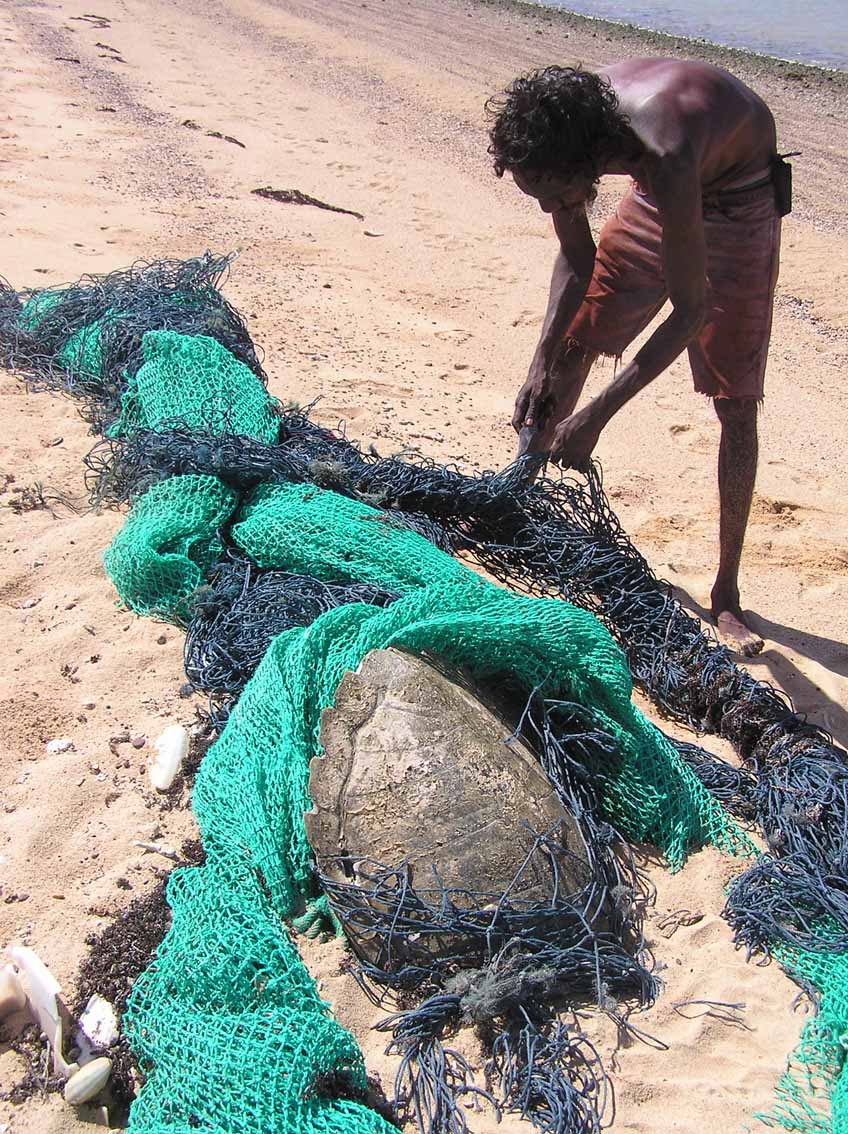By Andrea Wild
No, the problem is not ghost ships on the high seas, but ghostnets. Lost and abandoned fishing gear drifts around the world’s oceans and can continue fishing for decades.
With around 640,000 tonnes of fishing gear lost or discarded each year, ghostnets are a huge problem worldwide. Originating mainly from fisheries and Asia and Australia, ghostnets in Australia’s Gulf of Carpentaria are among the highest concentration in the world and are threatening our marine turtles. During a recent cleanup of ghostnets on beaches in the Gulf, 80 per cent of animals found trapped in nets were marine turtles, including Olive Ridley, Hawksbill, Green and Flatback turtles.

During a beach cleanup, an Indigenous ranger finds a ghostnet with a turtle entangled.
Picture: GhostNets Australia.
CSIRO, working with GhostNets Australia and Indigenous rangers, is identifying hotspots in the Gulf where ghostnets and turtles meet.
Using a model of ocean currents and data collected by Indigenous rangers on the number of ghostnets found during beach cleanups, the scientists simulated the likely paths ghostnets take to get to their landing spots on beaches in the Gulf of Carpentaria.
Combining this with information about the occurrence of turtles in the area, they found that entanglement risk for turtles is concentrated in an area along the eastern margin of the Gulf and in a wide section in the southwest extending up the west coast.
The research pinpoints where prevention and clean-ups can really make a difference to protecting our biodiversity.
Ghostnets, originating mainly from fisheries in Asia and Australia, are a particular problem in Australia’s Gulf of Carpentaria, where they can reach densities of up to three tonnes/km, among the highest recorded worldwide.
“Our research goes beyond discovering where ghostnet fishing is taking place, to actually estimating its impact on biodiversity, in particular on threatened marine turtles,” Dr Denise Hardesty of CSIRO said.
“Using a model of ocean currents and data collected by Indigenous rangers on the number of ghostnets found during beach cleanups, we simulated the likely paths ghostnets take to get to their landing spots on beaches in the Gulf of Carpentaria.
“Combining this with information about the occurrence of turtles in the area, we found that entanglement risk for turtles is concentrated in an area along the eastern margin of the Gulf and in a wide section in the southwest extending up the west coast.
“Most ghostnets enter the Gulf from the northwest and move clockwise along its shore. This means we can help protect biodiversity in the region by intercepting nets as they enter the Gulf, before they reach the high density turtle areas along south and east coastlines.”
Ghostnets are a global problem, capturing seabirds, marine mammals and sea turtles worldwide. Lost or abandoned fishing gear makes up only 20 per cent of marine debris but has a disproportionate effect because it is designed to capture wildlife.
“Our research shows that combining models of marine debris with species occurrence data could identify global hot spots for impact, helping pinpoint where prevention and clean-ups could really make a difference to biodiversity,” Dr Hardesty said.
This research used information on ocean currents generated by the BLUElink Ocean Data Assimilation System to simulate the paths of ghostnets.
Media: Andrea Wild. Ph: +61 2 6246 4087 Mb: 0415 199 434 E: andrea.wild@csiro.au

